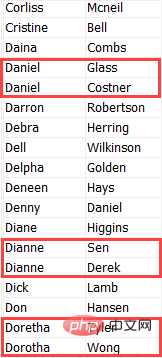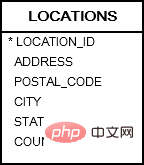How to sort query results in oracle
In Oracle, you can use the "SELECT" statement and the "ORDER BY" clause to sort the query. You can sort the query result set of one or more columns in ascending or descending order. The syntax "SELECT field name" FROM data table name ORDER BY field name [ASC|DESC]".

The operating environment of this tutorial: Windows 7 system, Oracle 11g version, Dell G3 computer.
In Oracle, you can use the "SELECT" statement and the "ORDER BY" clause to sort queries.
In Oracle, row data records are stored in the table in a non-specified order, regardless of the order in which the rows are inserted into the database. To query row records by column in ascending or descending order, you must explicitly instruct the Oracle database how to sort.
For example, you might want to list all customers alphabetically by name, or display all customers in order from lowest to highest credit limit.
To sort the queried data, add the ORDER BY clause to the SELECT statement as follows.
ORDER BY clause can sort the result set of one or more columns in ascending or descending order.
Syntax:
SELECT
字段名,
FROM
table_name
ORDER BY
字段名 [ASC | DESC] [NULLS FIRST | NULLS LAST]To sort the result set by a column, you can list the column after the ORDER BY clause.
It is a sorting order according to the column name, which can be:
ASCmeans sorting in ascending orderDESCmeans sorting in descending order
By default, the ORDER BY clause is used whether or not ASC is specified. Both sort the rows in ascending order. If you want to sort the rows in descending order, use DESC explicitly.
NULLS FIRST Place NULL values before non-NULL values, NULLS LAST before non-## Place the NULL value after the #NULL value.
ORDER BY clause can sort data by multiple columns, and each column may have a different sort order.
ORDER BY clause is always the last clause in a SELECT statement.
customers table in the sample database for demonstration.

customers) table: name, address and credit limit:
SELECT name, address, credit_limit FROM customers;

1. Example of sorting rows by column
#To sort customer names alphabetically in ascending order, use the following statement:SELECT name,address,credit_limit FROM customers ORDER BY name ASC;

ASC instructs Oracle to sort the rows in ascending order. But ASC is optional, and if omitted, by default, the ORDER BY clause sorts the rows by the specified column in ascending order.
ORDER BY name ASC
ORDER BY name
Explicitly use DESC after the column name in the clause, as shown below: <div class="code" style="position:relative; padding:0px; margin:0px;"><pre class='brush:php;toolbar:false;'>SELECT name, address, credit_limit
FROM customers
ORDER BY name DESC;</pre><div class="contentsignin">Copy after login</div></div>Execute the above query statement and get the following results-

2. Example of sorting rows by multiple columns To sort multiple columns, you can separate them with commas
ORDER BY each column in the sentence. See the following Contacts (
) table in the sample database. For example, to sort by
in ascending order and the last_name column in descending order, use the following statement: <div class="code" style="position:relative; padding:0px; margin:0px;"><pre class='brush:php;toolbar:false;'>SELECT first_name, last_name
FROM contacts
ORDER BY first_name, last_name DESC;</pre><div class="contentsignin">Copy after login</div></div>Execute From the above sample code, you can see the following results -
##As you can see from the screenshot above,  contact_id
contact_id
91 and 311The values of first_name of these two records are the same, and the values of last_name are arranged in descending order. In this example, Oracle first sorts the rows by first_name
last_name in descending order. See results similar to the following:
In the above result: 
- 首先,按
first_name升序排序。 - 其次,如果两个名字相同,按
last_name降序排列,如Daniel Glass和Daniel Costner,Dianne Sen和Dianne Derek,Doretha Tyler和Dorotha Wong。
3、按列位置排序行示例
不需要指定用于排序数据的列名称。如果您愿意,可以使用ORDER BY子句中列的位置。
请参考下语句 -
SELECT name, credit_limit,address FROM customers ORDER BY 2 DESC, 1;
在这个例子中,name列的位置是1,credit_limit列的位置是2。相当于以下查询语句 -
SELECT name, credit_limit,address FROM customers ORDER BY credit_limit DESC, name;
在ORDER BY子句中,使用这些列位置来指示Oracle对行进行排序。
4、用NULL值排序行的示例
请参阅示例数据库中的以下地区(locations)表:

以下语句按城市(city)和州(state)检索位置并对其进行排序:
SELECT country_id, city, state FROM locations ORDER BY state DESC;
执行上面查询语句,得到以下结果 -
state列有NULL值,这意味着state数据与某些城市(例如:Beijing, Hiroshima 和 London)无关。
当使用非NULL值对混合NULL进行排序时,Oracle允许指定哪个应该首先出现。
例如,以下语句按升序对state列进行排序,并首先将NULL值放置在前面。
SELECT country_id, city, state
FROM
locations
ORDER BY
state ASC NULLS FIRST;要放置NULL值在后面,可以使用NULLS LAST,如下面的语句所示:
SELECT country_id, city, state
FROM
locations
ORDER BY
state ASC NULLS LAST;执行上面示例查询语句,得到以下结果:
5、按函数或表达式排序数据
ORDER BY子句可在一列上应用一个函数,例如字符串函数,数学函数等,并按函数的结果对数据进行排序。
例如,以下语句使用ORDER BY子句中的UPPER()函数来区分客户名称的大小写:
SELECT customer_id, name FROM customers ORDER BY UPPER( name );
执行上面查询语句,得到以下结果 -
推荐教程:《Oracle教程》
The above is the detailed content of How to sort query results in oracle. For more information, please follow other related articles on the PHP Chinese website!

Hot AI Tools

Undresser.AI Undress
AI-powered app for creating realistic nude photos

AI Clothes Remover
Online AI tool for removing clothes from photos.

Undress AI Tool
Undress images for free

Clothoff.io
AI clothes remover

AI Hentai Generator
Generate AI Hentai for free.

Hot Article

Hot Tools

Notepad++7.3.1
Easy-to-use and free code editor

SublimeText3 Chinese version
Chinese version, very easy to use

Zend Studio 13.0.1
Powerful PHP integrated development environment

Dreamweaver CS6
Visual web development tools

SublimeText3 Mac version
God-level code editing software (SublimeText3)

Hot Topics
 Function to calculate the number of days between two dates in oracle
May 08, 2024 pm 07:45 PM
Function to calculate the number of days between two dates in oracle
May 08, 2024 pm 07:45 PM
The function in Oracle to calculate the number of days between two dates is DATEDIFF(). The specific usage is as follows: Specify the time interval unit: interval (such as day, month, year) Specify two date values: date1 and date2DATEDIFF(interval, date1, date2) Return the difference in days
 How long will Oracle database logs be kept?
May 10, 2024 am 03:27 AM
How long will Oracle database logs be kept?
May 10, 2024 am 03:27 AM
The retention period of Oracle database logs depends on the log type and configuration, including: Redo logs: determined by the maximum size configured with the "LOG_ARCHIVE_DEST" parameter. Archived redo logs: Determined by the maximum size configured by the "DB_RECOVERY_FILE_DEST_SIZE" parameter. Online redo logs: not archived, lost when the database is restarted, and the retention period is consistent with the instance running time. Audit log: Configured by the "AUDIT_TRAIL" parameter, retained for 30 days by default.
 The order of the oracle database startup steps is
May 10, 2024 am 01:48 AM
The order of the oracle database startup steps is
May 10, 2024 am 01:48 AM
The Oracle database startup sequence is: 1. Check the preconditions; 2. Start the listener; 3. Start the database instance; 4. Wait for the database to open; 5. Connect to the database; 6. Verify the database status; 7. Enable the service (if necessary ); 8. Test the connection.
 How to use interval in oracle
May 08, 2024 pm 07:54 PM
How to use interval in oracle
May 08, 2024 pm 07:54 PM
The INTERVAL data type in Oracle is used to represent time intervals. The syntax is INTERVAL <precision> <unit>. You can use addition, subtraction, multiplication and division operations to operate INTERVAL, which is suitable for scenarios such as storing time data and calculating date differences.
 How much memory does oracle require?
May 10, 2024 am 04:12 AM
How much memory does oracle require?
May 10, 2024 am 04:12 AM
The amount of memory required by Oracle depends on database size, activity level, and required performance level: for storing data buffers, index buffers, executing SQL statements, and managing the data dictionary cache. The exact amount is affected by database size, activity level, and required performance level. Best practices include setting the appropriate SGA size, sizing SGA components, using AMM, and monitoring memory usage.
 How to see the number of occurrences of a certain character in Oracle
May 09, 2024 pm 09:33 PM
How to see the number of occurrences of a certain character in Oracle
May 09, 2024 pm 09:33 PM
To find the number of occurrences of a character in Oracle, perform the following steps: Get the total length of a string; Get the length of the substring in which a character occurs; Count the number of occurrences of a character by subtracting the substring length from the total length.
 How to replace string in oracle
May 08, 2024 pm 07:24 PM
How to replace string in oracle
May 08, 2024 pm 07:24 PM
The method of replacing strings in Oracle is to use the REPLACE function. The syntax of this function is: REPLACE(string, search_string, replace_string). Usage steps: 1. Identify the substring to be replaced; 2. Determine the new string to replace the substring; 3. Use the REPLACE function to replace. Advanced usage includes: multiple replacements, case sensitivity, special character replacement, etc.
 Oracle database server hardware configuration requirements
May 10, 2024 am 04:00 AM
Oracle database server hardware configuration requirements
May 10, 2024 am 04:00 AM
Oracle database server hardware configuration requirements: Processor: multi-core, with a main frequency of at least 2.5 GHz. For large databases, 32 cores or more are recommended. Memory: At least 8GB for small databases, 16-64GB for medium sizes, up to 512GB or more for large databases or heavy workloads. Storage: SSD or NVMe disks, RAID arrays for redundancy and performance. Network: High-speed network (10GbE or higher), dedicated network card, low-latency network. Others: Stable power supply, redundant components, compatible operating system and software, heat dissipation and cooling system.









